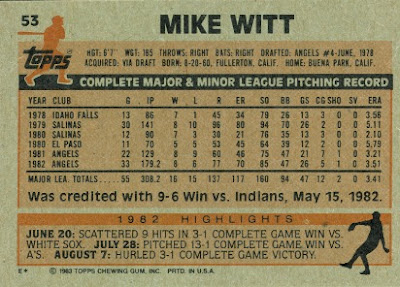Card: This card is Mookie Wilson's third Topps card. He was featured along with Hubie Brooks and Juan Benrenguer on a three player future stars card in the '81 set for his rookie card.
Pic: Nice action shot of Wilson following through and starting his way out of the box. Topps used a similar action shots of Wilson in '82 and later in '88. As you can see in the inset, Mookie is generally pretty happy guy.
Player: Mookie Wilson was a second round pick by the Mets out of the University of South Carolina in the 1977 draft. Wilson spent four years in the minors batting .290+ in three of the four and averaged 40 stolen bases per year. He was called up in Septemeber of 1980 and was allowed to start 26 of the Mets last 30 games. The 24 year-old centerfielder hit .248 and stole seven bases in his first taste of big league action.
Wilson made the Mets out of spring training in '81. He started in right field for the for the first six weeks, then moved to centerfield in May. He batted .271 with 24 steals in the abbreviated season. Over the next three seasons Wilson was the Mets everyday centerfielder and performed consistently, posting batting averages of .279, .276, and .276. The speedy Wilson was a base stealing weapon swiping 58, 54, and 46 bases over the '82-'84 seasons.
An arm injury and the arrival of Lenny Dykstra cut into Wilson's playing time in 1985. Limited to 93 games, Wilson hit .276 for the third year in a row and added 24 steals.
Wilson's '86 season of course was highlighted by his ground ball through the legs of Bill Buckner in Game 6 of the World Series. Wilson and his Mets pulled off the miraculous comeback to win the game and the series. From the '86 through '88 seasons Wilson was a semi regular sharing centerfield with Dykstra and filling in often in left and rightfield. Although not an everyday starter he recorded between 378 - 385 at bats each year and posted batting averages of .289, .299, and .296. The Mets again reached the post season in '88 but Wilson could only manage two hits in the NLCS loss against the Dodgers.
Wilson continued in his semi-regular role with the Mets in '89 but with him batting .205 and the Mets mired in a seven game losing streak, he was dealt to the Blue Jays at the trade deadline for Jeff Musselman and Mike Brady (no not that one!). Wilson batted .298 for Toronto and helped push them into the postseason. He batted .263 in four games as the Blue Jays bowed out of the ALCS losing to the A's.
Wilson was Toronto's everyday centerfield in 1990 batting 265 and stealing 23 bases in 27 attmepts. With the acquisition of Devon White for the '91 season, Wilson started occasionally in left field and was deployed as a pinch runner and pinch hitter. In 86 games Wilson batted only .246. The Blue Jays won the AL East and Wilson would get two hits in eight at bats before the ALCS was decided in the Minnesota Twins favor.
At 35 years of age Wilson was no longer able to cover as much ground in the outfield and wasn't getting on base consistently, so he hung up the spikes.
Flipside: Wilson also had three four-hit games during the '82 season.
Oddball: Mookie's given name is William. It's a good thing he went by Mookie , 'cos it could have been confusing during the 80's with two speedy centerfielders named Willie Wilson.
Mookie got his nickname for the way he pronounced the word milk when requesting it as a young child.
History: Wilson will always be remembered as the batter who hit the grounder through Bucker's legs in the '86 World Series. With his speed, managers were tempted to bat him at the top of the lineup but Wilson never walked more than 35 times in a season. Taking a few more walks would have made him even more valuable given his career 77% success rate when stealing bases.
After retirement Wilson has worked as a coach for the Mets. Wilson is the stepfather and uncle of former baseball player Preston Wilson. (In case you are wondering...Mookie's brother fathered Preston four years before Mookie married Preston's Mom).























